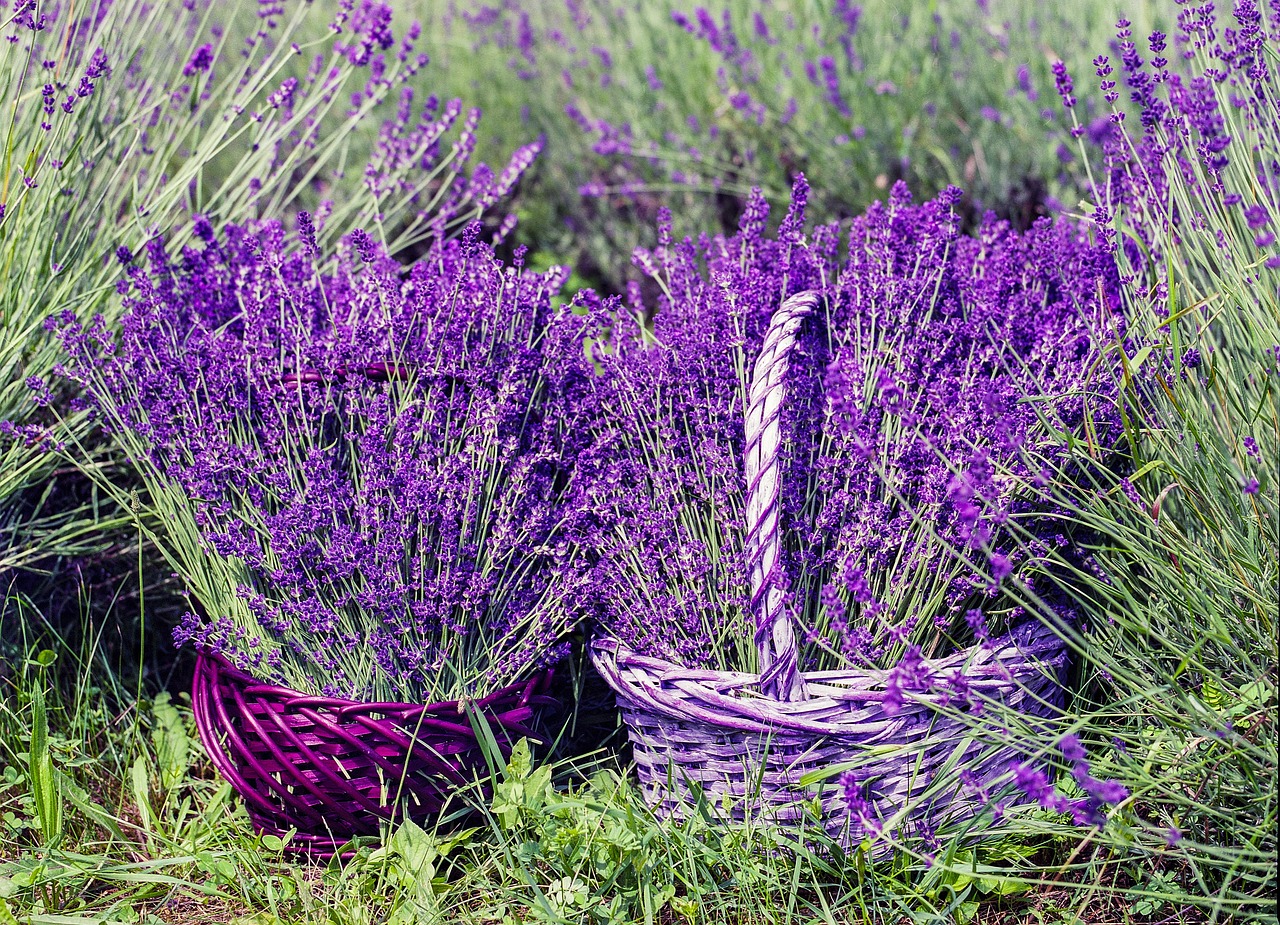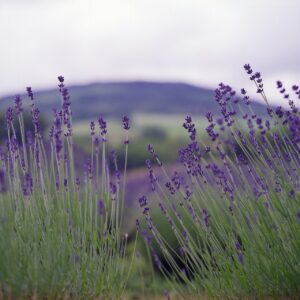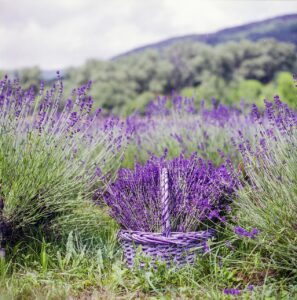Lavender
Overview
Lavender, cherished for its fragrance and beauty, is a sturdy, shrub-like plant from the Lamiaceae family. Its iconic purple spikes and silver-green leaves are not only ornamental but also widely used in culinary, medicinal, and aromatic applications, proving its versatility in various aspects of daily life.

Characteristics
Known for its aromatic fragrance, purple flowers, and drought-resistant qualities.
Region
Lavender is commonly grown in the Mediterranean, Europe, and increasingly in various regions of the United States and Australia.
Natural Habitat
Typically found in open and sunny habitats, including Mediterranean fields and rocky outcrops.
Cultivation
Prefers full sunlight, moderate watering, and well-draining, slightly alkaline soil.
Uses and Benefits
Lavender captivates with more than its enchanting scent and elegant form; it’s a powerhouse of versatility. This herb not only makes for fragrant floral arrangements and potpourri but can also be a charming addition as a culinary herb, infusing a sweet, floral flavor into desserts and teas4. But lavender’s benefits extend even further.
Rich in soothing properties, lavender is frequently used in aromatherapy to alleviate stress and promote relaxation1. Its calming presence can be enjoyed in various ways:
- Woven into a beautiful wreath
- Dotting a refreshing lavender-infused lemonade
- Used in soothing bath salts or body lotions
- Placed in sachets to freshen up closets and drawers
In the garden, lavender is not only a visually stunning addition but also a practical one. Its deer-resistant properties make it an ideal choice for gardeners looking to create a tranquil, pest-free environment3.
Embrace the versatility and timeless appeal of lavender, whether it’s in your garden or your home. As a beautiful, fragrant plant or a natural stress reliever, lavender is sure to be cherished in any form. Experience the joy of growing and using this incredible herb, and discover the many ways it can enhance your life.

Cultivation Tips
To cultivate lavender successfully, start by sowing your seeds indoors during the latter part of winter. As the signs of spring emerge, that’s your cue to transplant them outside. Choose a sunny spot—Lavandula simply adores basking in the full sunlight.
Ensure the soil is warm and well-draining; lavender thrives in slightly alkaline conditions but will not tolerate wet feet. To keep your lavender happy, incorporate gravel or sand into the soil for improved drainage1. If you’re in a region cold enough for winter frosts, prioritize your winter drainage to safeguard these hardy beauties from waterlogged woes.
Regular pruning will help maintain shape and encourage robust growth. Follow these tips for lavender success:
- Prune established plants heavily in the spring, cutting back at least one-third of the green growth.
- Deadhead spent blooms to promote continuous flowering throughout the season.
- After the flowering season, lightly trim your plants to maintain a tidy appearance and prevent woody stems.
With tender care, lavender will reward you with vibrant, aromatic blooms that evoke the essence of a serene garden. Enjoy the fruits of your labor as these delightful plants attract pollinators and infuse your outdoor space with their soothing fragrance.
Seasonal Considerations
To cultivate lavender successfully, start by sowing your seeds indoors during the latter part of winter. As the signs of spring emerge, that’s your cue to transplant them outside. Choose a sunny spot—lavender adores basking in full sunlight.
Ensure the soil is warm and well-draining; Lavandula thrives in slightly alkaline conditions but will not tolerate wet feet. To keep your lavender happy, incorporate gravel or sand into the soil for improved drainage1. If you’re in a region cold enough for winter frosts, prioritize your winter drainage to safeguard these hardy beauties from waterlogged woes.
Regular pruning will help maintain shape and encourage robust growth. Remember, tender care will go a long way, rewarding you with vibrant, aromatic blooms that evoke the essence of a serene garden.
- Sow seeds indoors in late winter
- Transplant outdoors in spring
- Choose a sunny location
- Ensure well-draining, alkaline soil
- Add gravel or sand for drainage
- Prioritize winter drainage in cold regions
- Prune regularly for shape and growth

Issues and Troubleshooting
While lavender is quite the resilient herb, it does have its share of issues, with root rot ranking as a lead troublemaker. If your lavender’s roots are sitting in wet soil, they’re at risk. The key to keeping this aromatic gem happy is striking the perfect balance with watering – just enough to quench its thirst but not so much that its feet get cold and soggy.
Another hiccup you might encounter is lavender’s sensitivity to extreme cold, especially in wet winters. Proper winter drainage can be a lifesaver here1. To ensure your lavender survives the chilly months, consider these tips:
- Plant lavender in well-draining soil to prevent water from pooling around the roots
- Protect plants from harsh winds and frost by covering them with a breathable fabric
- Prune back any damaged or dead foliage in early spring to encourage new growth
Also, keep a watchful eye for pests and diseases, although, thankfully, these are less common thanks to lavender’s natural resilience. Common issues include:
- Fungal diseases: Look out for powdery mildew or leaf spot, which can cause discoloration and damage to foliage
- Insect pests: Watch for aphids, whiteflies, or spittlebugs that may feed on the plant’s sap
If you do notice any signs of trouble, act quickly to address the problem before it spreads. Remove affected parts of the plant and consider using a natural, organic treatment if necessary.
With a little care and the right conditions, your lavender should thrive, filling your garden with color and fragrance. By staying vigilant and providing your plants with the proper drainage, water, and protection they need, you can enjoy a healthy, vibrant lavender harvest for years to come.
History and Folklore
Lavender, with its tranquil scent and vibrant hues, has waltzed through history and folklore alike. This fragrant plant has weaved itself into countless tales and traditions. In ancient times, it was cherished by the Romans and Egyptians for its bathing and cooking rituals, as well as for the mummification process2. Lavender’s name itself is thought to stem from the Latin “lavare,” meaning “to wash,” highlighting its historical use in cleansing practices.
Fast forward to the Middle Ages, and lavender’s mystical reputation blossomed. People believed it could ward off evil spirits and the infamous plague. Bouquets of lavender were popularly carried for both their purported protective properties and delicate aroma2. Even the language of flowers—a Victorian-era mode of hidden communication—held lavender in high regard, symbolizing devotion and virtue.
As you delve into the soothing world of this cherished herb, its storied past will surely enrich the experience of growing or using it. Consider these fascinating historical tidbits:
- Ancient Egyptians used lavender in their mummification process and perfumes
- Romans favored lavender for its cleansing properties in baths and cooking
- In the Middle Ages, lavender was believed to protect against evil spirits and the plague
- Victorian flower language associated lavender with devotion and virtue
Embracing lavender’s rich history can add depth and meaning to your gardening or wildcrafting pursuits. As you nurture this timeless plant, you’ll be participating in a tradition that spans centuries and cultures.
Nicolas Duval
Nicolas is a passionate advocate for nature and the art of wildcrafting. His dedication shines through in Wildcraftia, a website he meticulously crafted to serve as a haven for nature enthusiasts worldwide. Driven by a deep appreciation for nature’s connection to humanity, Nicolas embarked on his journey in 2011 with SmokableHerbs, a platform showcasing his love for nature’s bounty. Building upon this foundation, he established Smokably, a thriving online store offering premium herbs and blends to a global audience.
